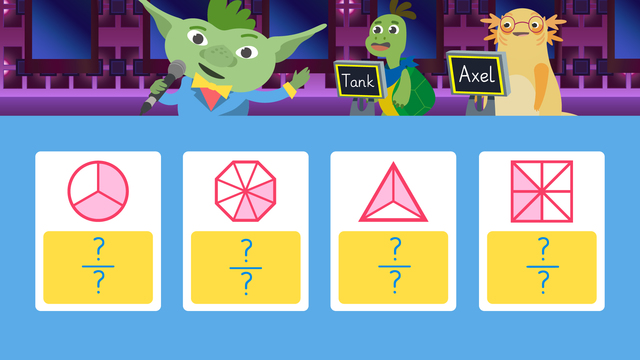Different Shapes, Same Fractions


Basics on the topic Different Shapes, Same Fractions
Fractions of shape
Sometimes we might need to match different shapes that represent the same fractions. Let’s learn more about finding fractions of a shape.
Fractions of a shape
We may be presented with a shape split into 8 equal parts. 3 of those parts are shaded in. In order to find the fraction being represented, we must first identify the denominator by counting all of the equal parts- 8. Next, we must identify the numerator by counting all of the shaded parts- 3. Finally, we can write the fraction the shaded parts are representing- $\frac{3}{8}$.
Finding fractions of a shape: Summary
In order to find the fraction a shape is representing:
- First, identify the denominator by counting all of the equal parts.
- Next, identify the numerator by counting all of the shaded parts.
- Finally, write the fraction
Fractions of shape worksheet and further practice
To continue your learning, have a look at our fractions of a shape worksheet and see if you can spot different shapes representing the same fractions. Also, check out our interactive exercises and activities.
Transcript Different Shapes, Same Fractions
"And now, for the next game..." "please welcome, AXEL and TANK!"
If they can win the game, Axel and Tank can open the secret prize door and see what is behind it! To play the game, they need to identify the fraction that is being represented by the shape and match them up in pairs to show the same fraction being represented by different shapes! Let's get ready to play "Different shapes, same fractions"! A fraction can be represented by any shape as long as the shape is divided EQUALLY into parts and a number of those PARTS are shaded in! So how can we identify the fraction that a shape is showing us? First, "identify the denominator", or the bottom number, by counting ALL of the parts in the shape. With this shape, there are EIGHT parts in total, so the denominator is EIGHT. Next, "identify the numerator", or the top number, by counting all of the SHADED parts of the shape. This shape has THREE parts shaded in, so the numerator is THREE. Finally, "write the fraction" the shaded parts of the shape represent. The shaded parts represent three eighths. Let's look at one more before you help Axel and Tank! Here is the second shape. There are THREE parts in total, so the denominator is THREE. There are TWO parts shaded in, so the numerator is TWO. The shaded parts represent two thirds! Now you know how to identify the fraction a shape is showing, it's time to help Axel and Tank WIN THAT PRIZE! Here is the first shape. What is the fraction being represented by the shaded parts?
They represent two thirds because there are three parts altogether, and two parts are shaded in. There is one last card to solve. Here it is! What is the fraction being represented here?
It is three eighths because there are eight parts altogether, and three parts are shaded in. Let's help Axel and Tank match the cards up! The shaded parts of THIS shape and THIS shape both represent two thirds, so match them up. The shaded parts of THIS shape and THIS shape both represent three eighths, so match them up. It looks like Axel and Tank have WON THE PRIZE! Before we see the prize they have won, let's review! Remember, to identify which fraction the shaded parts of a shape represent, first, "identify the denominator by counting ALL of the parts" in the shape. Next, "identify the numerator by counting all of the SHADED parts" of the shape. Finally, "write the fraction the shaded parts of the shape represent". Axel and Tank, CONGRATULATIONS! Head to the secret prize room to COLLECT YOUR PRIZE!
"Wait, this is the prize?" "But Axel, the prize IS our home!"
Different Shapes, Same Fractions exercise
-
Can you find the shapes with the same shaded fractions?
HintsCan you work out what fraction of each shape is shaded before finding a matching one? Look at the total number of parts to help.
In this example, $\frac{1}{2}$ of the shape is shaded as 1 of 2 equal parts is shaded.
Solution- The square and the rectangle both had $\frac{1}{4}$ shaded.
- The circle and the triangle both had $\frac{1}{3}$ shaded.
- The star and the pentagon both had $\frac{1}{5}$ shaded.
- The heart and the hexagon both had $\frac{1}{2}$ shaded.
-
Can you assign the shape to the matching fraction?
HintsHow many parts has each shape been split into? That is the denominator.
How many parts are shaded in? That is the numerator.
For example, this circle has been split into three equal parts and one part is shaded, so it would be assigned to $\frac{1}{3}$.
Solution- Find the number of equal parts the shape has been split into; this is the denominator.
- Find the number of parts that have been shaded; this is the numerator.
-
Which is the correct shape?
HintsHow many parts is the shape split into? This should be the same as the denominator.
How many parts are shaded? This should be the same as the numerator.
Remember:
- the top number is the numerator.
- the bottom number is the denominator.
SolutionThe shapes that should have been highlighted are:
- $\frac{1}{6}$ - the circle, as it is split into six equal parts and one is shaded in.
- $\frac{3}{5}$ - the star, as it is split into five equal parts and three are shaded in.
- $\frac{4}{7}$ - the hepatgon, as it is split into seven equal parts and four are shaded in.
- $\frac{3}{5}$ - the rectangle, as it is split into ten equal parts and seven are shaded in.
These shapes were incorrect because:
- The hexagon had only 2 parts shaded.
- The pentagon had only 2 parts shaded.
- The rectangle on the third row was only split into 6 equal parts.
- The square was only split into 8 equal parts.
-
Which fractions are being represented?
HintsFind out how many equal parts the shape has been split into and how many parts are shaded.
Remember:
- the numerator (top number) represents the shaded parts.
- the denominator (bottom number) represents the total number of equal parts.
SolutionHere are the correct fractions:
Circle
- The circle has 7 equal parts and 3 are shaded.
- The matching fraction is $\frac{3}{7}$.
- The rectangle has 9 equal parts and 5 are shaded.
- The matching fraction is $\frac{5}{9}$.
- The hexagon has 6 equal parts and 2 are shaded.
- The matching fraction is $\frac{2}{6}$.
- The square has 4 equal parts and 2 are shaded.
- The matching fraction is $\frac{2}{4}$.
- The rhombus has 8 equal parts and 6 are shaded.
- The matching fraction is $\frac{6}{8}$.
- The rectangle has 8 equal parts and 2 are shaded.
- The matching fraction is $\frac{2}{8}$.
-
Which shapes are $\frac{1}{3}$ shaded?
Hints$\frac{1}{3}$ has a numerator of 1, so you are looking for shapes that only have 1 part shaded.
$\frac{1}{3}$ has a denominator of 3, so you are looking for shapes that are split into 3 equal parts.
SolutionThis circle and triangle both have $\frac{1}{3}$ shaded.
They are both split into 3 equal parts and both have 1 part shaded.
-
Find the pairs.
HintsCreate a fraction for each shape by finding how many equal parts the shape is split into and how many are shaded.
Remember:
- the shaded parts represent the numerator (top number)
- the total number of equal parts represent the denominator (bottom number)
Can this fraction be simplified? To simplify a fraction we look for a factor that both the numerator and denominator share.
For example, we could simplify $\frac{2}{4}$ to $\frac{1}{2}$ by dividing both the numerator and the denominator by 2.
$\frac{6}{8}$ of the circle is shaded. If we divide both the numerator and denominator by 2, what do we get?
Solution$\frac{3}{4}$
- The circle and the rhombus should have been highlighted in green.
- The circle has $\frac{6}{8}$ shaded which can be simplified to $\frac{3}{4}$ by dividing the numerator and denominator by 2.
- The rhombus has $\frac{9}{12}$ shaded which can also be simplified to $\frac{3}{4}$ by dividing the numerator and denominator by 3.
- The triangle and the tall rectangle should have been highlighted in blue.
- The triangle has $\frac{1}{3}$ shaded which cannot be simplified further.
- The tall rectangle has $\frac{3}{9}$ shaded which can be simplified to $\frac{1}{3}$ by dividing the numerator and denominator by 3.
- The star and the wide rectangle should have been highlighted in violet.
- The star has $\frac{1}{5}$ shaded which cannot be simplified further.
- The wide rectangle has $\frac{3}{15}$ shaded which can be simplified to $\frac{1}{5}$ by dividing the numerator and denominator by 3.
- The square and the hexagon should have been highlighted in yellow.
- The square has $\frac{6}{9}$ shaded which can be simplified to $\frac{2}{3}$ by dividing the numerator and the denominator by 3.
- The hexagon has $\frac{4}{6}$ shaded which can also be simplified to $\frac{2}{3}$ by dividing the numerator and denominator by 2.
 Do you want to learn faster and more easily?
Do you want to learn faster and more easily?










